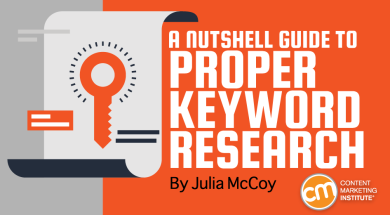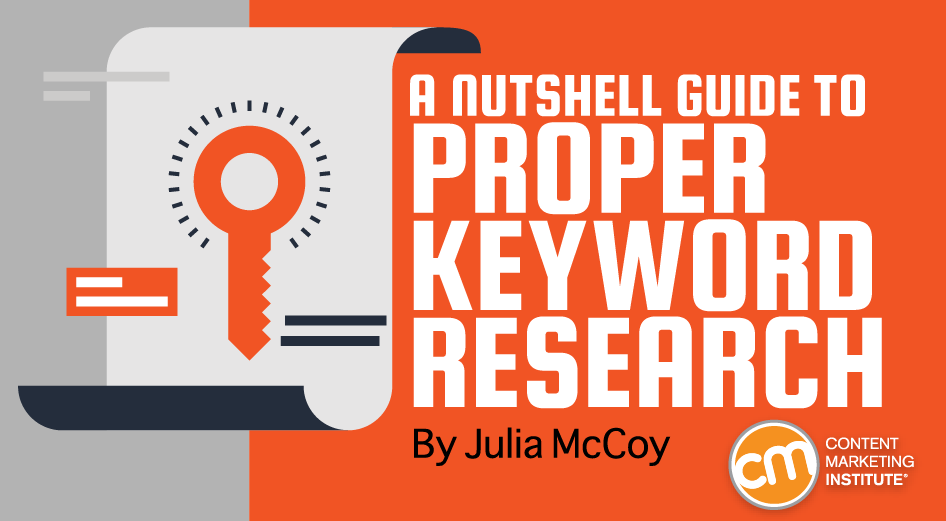
Keywords aren’t the end-all, be-all strategy (so to speak) in creating online content. If there’s one thing I’ve learned writing a myriad of content all over the web, it’s that you should think about your reader first and foremost. Otherwise, you won’t be creating the content necessary to stand out to your audience.
If you use keywords correctly, though, you use the voice of your customers and target audience. And keyword research allows you to target your message and stand out in your industry.
While the importance of keyword research has remained steady, the methods have evolved in concert with more intelligent search engines and changing user preference.
Here’s my brief but functional guide to keyword research.
Future-Proof Your Content Rankings With These SEO Tips
Starting grounds: Semantic search shapes keywords
One primary reason that keyword research has become so much more complicated over the past several years is that search engines have changed. Instead of combing through content to pull out individual keyword phrases, today’s search engines are operating largely on the basis of semantic search.
Search engines today are operating largely on the basis of semantic search says @JuliaEMcCoy #SEO Click To TweetSemantic search also is called intent-based search. It’s something that search engines gravitate toward more and more. The reason is that, in addition to searching from a variety of devices, today’s consumers are searching with a different set of queries. Ten years ago, a searcher may have typed, “Bagels New York.” Today’s searcher may use voice-activated search assistants and say, “Find me cheap bagels in New York,” or better yet, “Best breakfast places in New York.”
This change indicates a migration from cut-and-dry keyword phrases toward the searcher’s intent and context. While the searcher asking for breakfast places may not have explicitly mentioned bagels, today’s search engines are smart enough to understand that bagels and breakfast go hand in hand. A set of results listing bagel places likely would be relevant to this searcher.
Creating Content for Google’s RankBrain
3 ways to find intent-based keywords
As semantic search rises to prominence, the importance of intent and contextual meaning is more profound than ever. Today’s marketers need to research keywords with these important foundations in mind.
Here are a few tips to help you get started:
- Put together a list of foundational keywords
Your foundational keywords are the ones that align closely with your target phrase. These keywords give the rest of your content meaning and structure. Without them, it’s difficult to do any other keyword research that’s even moderately effective or lucrative.
Your foundational keywords should align closely with your target phrase says @JuliaEMcCoy #SEO Click To Tweet
If you’re not sure what your foundational keywords are, write the most basic queries your customers would use to find your company’s products or services. These base keywords will be used to develop more advanced keyword ideas.
Tip: A great way to find these foundational keywords is by asking, “What is the most common phrase my clients or prospects would use to find me?”
- Head to auto-suggest
Auto-suggest is a surprisingly simple yet hugely effective way to figure out which keywords to target. For example, a company that sells dog toys uses Google’s auto-suggest feature to learn the keywords used more frequently by searchers:

While auto-suggest isn’t the holy grail of keyword research, it can help you use overlooked keyword phrases or parallel phrases you hadn’t considered.
- Hone and prioritize best keywords
We’re going to get a bit more technical here, so sit tight while I run down some guidelines on finding your best keywords.
What makes your “best” keyword? Well, this comes down to which keywords are the best in terms of several factors: Monthly search volume (high is best), keyword difficulty (lower means easier), a cost-per-click (cost presence on Google’s AdWords marketplace), and a competitive density.
The common factors that define a keyword’s value are:
- Volume (amount of monthly searches)
- KD (keyword difficulty – different tools have different names for this)
- CPC (cost-per-click, suggested bid—this shows the monetary value of a keyword and what advertisers are willing to spend)
- Com (competitive density)
Here is an example of how the definitions are used in the SEMrush keyword analytic search for the term “copywriter.”
Click to enlarge
Remember, the way that you prioritize your keywords will depend largely on how you want to influence search results. If you want to target high-volume keywords, you’ll prioritize them first, whereas if you want to target low-volume, specific keywords, you’ll move them to the top of the list and target them more aggressively. Each approach has its pros and cons, and what you ultimately choose depends on your goals.
Modern tools to improve research
Nowadays, you can use several innovative tools and tricks to take your keyword research to the next level. In addition to helping you use keywords in a more innovative and effective way, these tools and tricks also can ensure that you’re targeting your keyword research toward today’s intent-based consumers.
- Survey your users
While many marketers agonize over keyword research, few think to ask their customers what search queries they’re using to find the products, goods, and services. Sites like Seed Keywords are fantastic for this. With Seed Keywords, you enter a simple scenario and instantly receive a URL to survey your customers. They respond to the scenario and you gain instant insight into which keywords you should target.

While it’s certainly not rocket science, this tool can help fill in gaps in your keyword research policy and gain insights that even some of the more expensive keyword research tools cannot afford you.
- Use keyword data from your competitors
Tools like SEMRush are best known for giving marketers keyword domain ranks according to Google data. This information can be helpful in choosing which keywords to target and where you’re going to diverge from your competition. Using SEMRush, you can evaluate which keywords are performing well in your industry and decide whether to add them to your keyword research strategy. (We’ll discuss more on how to use this tool later.)
How to Improve Your Page Ranking for a Specific Keyword
- Write for humans
Because search engines have changed on a foundational level, the way that you include keywords in your copy needs to change as well. Gone are the days of keyword density obsessions and stuffy keyword phrases inserted awkwardly into content. Today’s content is all about user intent, which often boils down to context. By using keywords and synonyms to create context around your keyword phrases of choice, you can provide your users with a more complete, relevant, and useful search experience.
By writing content that holds reader experience at the pinnacle of importance, you’re positioning yourself to make the most of the trend toward semantic search in the post-Hummingbird world and to provide more relevant results to your users. Building content that is based around relevant topics, important themes, and valuable information for your audience is a more solid keyword strategy than targeting one or two keyword phrases. Because of this, today’s content creator can afford to focus less on keyword phrases and more on context and relevance.
How Google Judges Quality and What You Should Do About It
5 more research tools
Thanks to the long history of keyword research, it’s not difficult to find keyword research tools that provide a wealth of information with a little investment. The previously referenced SEMRush has long dominated the keyword research field – it remains the leader. Some of the other great tools that I use include:
Wordtracker allows marketers to research the highest-performing keywords. One of the most popular among SEOs, the free tool offers users access to a database that includes hundreds of millions of Google searches to gain insight into productive keywords. Ideal for finding keywords that will perform well and draw ample traffic to a page, Wordtracker is a fantastic tool for beginning to advanced SEOs and marketers.
Another oldie but goodie, Google’s Keyword Planner is free and integrates seamlessly with AdWords. Ideal for the early stages of keyword research, Keyword Planner can be used to determine a set of foundational keywords and build from there.
Authority Labs is a daily SEO monitoring tool that allows users to enter a keyword list and track the resulting Google rankings. The tool also allows users to track results on Yahoo and Bing. Authority Labs users can keep an eye on mobile ranking vs. desktop ranking, and get a series of extensive keyword insights to help ensure that they are targeting the right phrases for their marketing material. Finally, the tool offers an extensive report that combines Google Analytics data, competition information, and rankings in one convenient place.
Keyword Spy is great for marketers to research keywords used by their competitors or to conduct keyword research on URLs. It’s also fantastic for building targeted campaigns and getting access to regional analytics and information. This paid service offers professional account options.
For marketers interested in semantic keyword research, BuzzSumo is the go-to tool. It can be used to find the most shared content on a given keyword or search phrase. That information can then be exported and analyzed with a simple text analysis service. Here’s an example of a search for “content marketing” in BuzzSumo:
Click to enlarge
This simple step can allow marketers to extract a list of semantically rich keyword phrases that can be used to build content. BuzzSumo is also fantastic for marketers who want to research which topics are going to produce the most exposure and drive the most traffic to a site.
Conclusion
While keyword research is still an important part of SEO, it’s changed drastically over the last several years.
Fortunately, marketers who are comfortable focusing less on strict keyword phrases and density measurements and more on intent, context, and relevance can create a varied and profitable keyword strategy that will help them create quality content readers and that search engines will love.
Please note: All tools included in our blog posts are suggested by authors, not the CMI editorial team. No one post can provide all relevant tools in the space. Feel free to include additional tools in the comments (from your company or ones that you have used).
Stay updated on the latest evolution of content marketing tools and tricks. Sign up for the free daily or weekly CMI newsletter.
Cover image by Joseph Kalinowski/Content Marketing Institute






